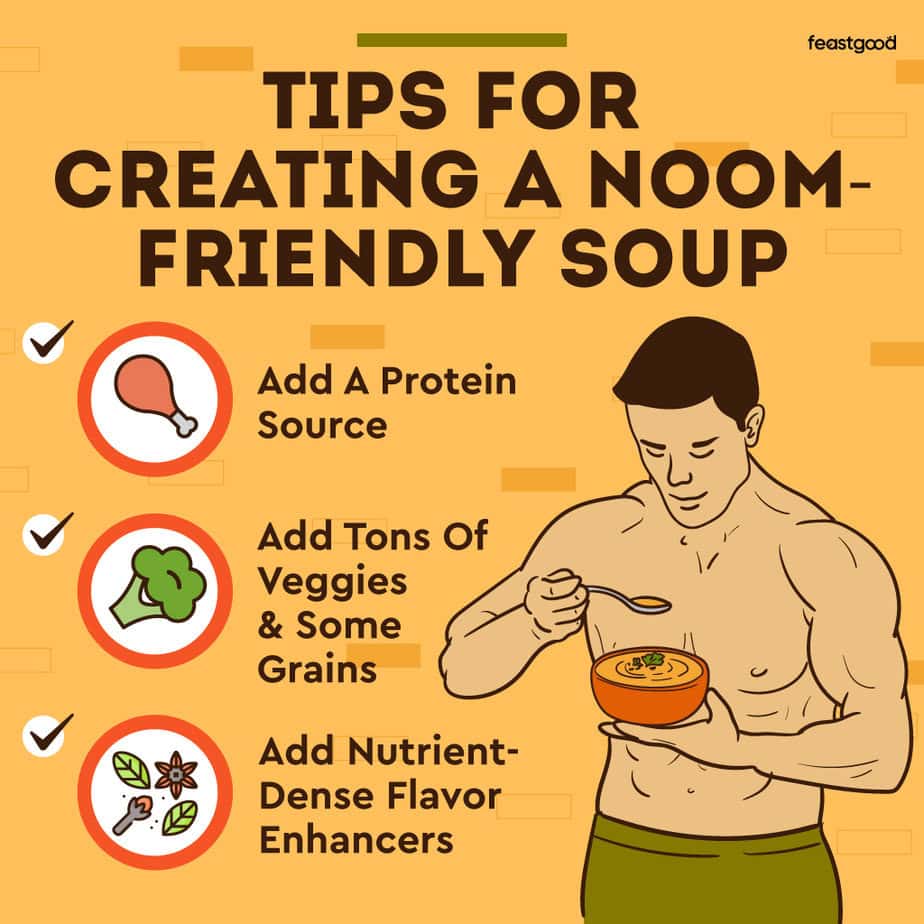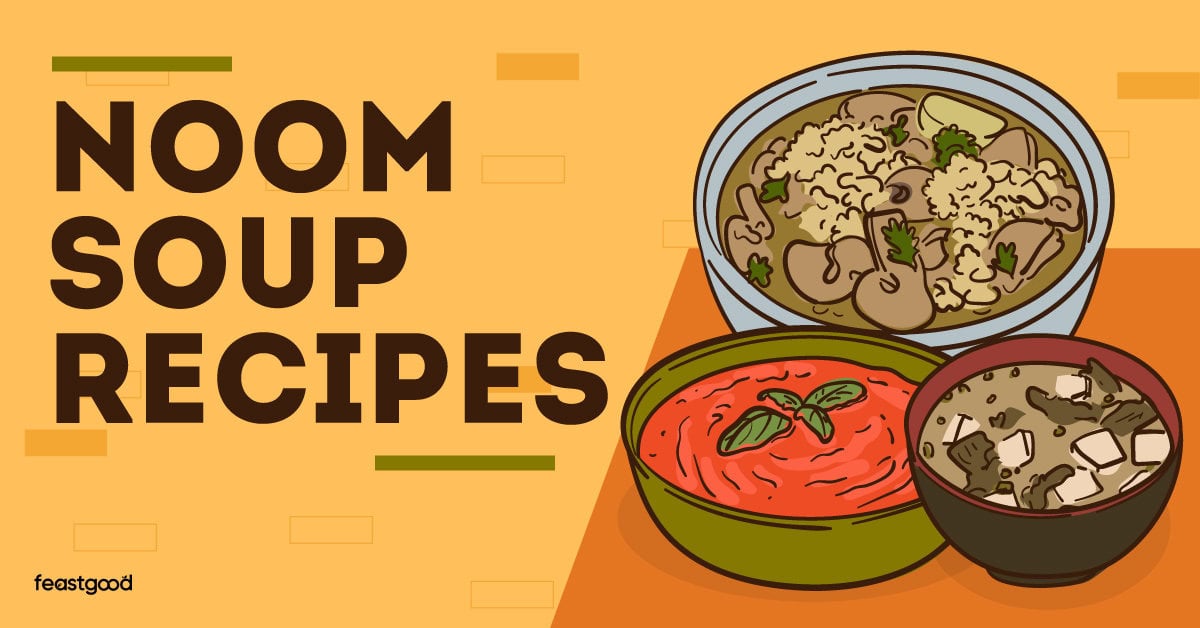Below, I’ve curated the 15 best noom-friendly soup recipes, which have been selected based on my experience as a Dietitian and someone who has used the Noom app extensively.
Soups can have a wide calorie range, from very high to very low. So if you’re on Noom, it’s important to find recipes that fit within your calorie budget to help you lose weight.
What Makes A Noom-Friendly Soup?
A Noom-friendly soup is a soup containing plenty of low-calorie, nutrient-dense foods.
Noom uses green, yellow, and red colors to categorize foods so that users know which foods are lower in calories and which are higher in calories.
- Green foods describe foods like fruits, veggies, and fat-free dairy that contain many nutrients and few calories. These foods should make up the bulk of your soup recipe.
- Yellow foods are mostly whole foods like beans, cheese, and lean meats that are still high in nutrients but are slightly more calorie-dense. As such, you should eat them in smaller amounts, but they’re still acceptable in a Noom-friendly soup recipe.
- Red and orange foods, like sugary treats or oils, should only be eaten occasionally because they have many calories. Some red/orange foods are high in food additives like sweeteners or preservatives and are poor in nutrients; others are very nutrient-dense, like nuts and seeds.
To eat soup while on Noom, pick one with plenty of green foods, some yellow foods, and limited amounts of red/orange foods.
3 Tips For Creating A Noom-Friendly Soup

Tip #1: Add A Protein Source
Include lean protein such as chicken breast, low-fat ground beef, low-fat dairy like Greek yogurt, ricotta, cottage cheese, or plant-based protein like tofu, legumes, or soya.
Although most of these proteins are considered yellow foods, including them in your soup is important because they keep you full for longer periods.
If your soup doesn’t have a protein source, you’ll be hungry again within an hour, making it more difficult to stick to your calorie range.
Add a lean protein source to increase satiety, manage cravings, and make adhering to your calorie range easier.
Tip #2: Add Tons Of Veggies & Some Grains
Adding vegetables to your soup can help to increase your consumption of green foods, add some fiber to help promote healthy digestion, and provide you with tons of nutrients.
Having a soup chock full of non-starchy veggies will help you fill up on fewer calories, which can help with portion control and adhering to your calorie range.
Non-starchy vegetables include broccoli, cauliflower, spinach, onion, cabbage, kale, and bell peppers.
I also recommend adding some starchy vegetables or grains to your soup, as these will provide energy and serve as an additional source of fiber.
Starchy vegetables include potatoes, corn, and peas. Grains include rice, pasta, and quinoa.
Tip #3: Add Nutrient-Dense Flavor Enhancers
My last tip is to use a combination of aromatics, herbs, and spices to add flavor to your soup because these are generally low in calories and packed full of flavor.
Amping up the flavor of your soup is important so that you enjoy what you’re eating. The more you enjoy the meals you eat on Noom, the easier it’ll be to stick with it.
Some examples of flavor enhancers include:
- Aromatics like onion, garlic, celery and carrots
- Herbs like fresh dill, fresh basil, or dry oregano
- Spices like coriander, cumin, and chili
- Acidity from lemon juice or white/red wine (optional)
15 Noom Soup Ideas
1. Minestrone
This soup is an Italian-inspired dish made without animal products and thus suitable for a plant-based diet. It is made with various vegetables, such as tomatoes, carrots, beans, and pasta, simmered in a vegetable broth.
This soup is a Noom-friendly choice because it contains green foods that offer tons of micronutrients (vitamins & minerals).
Adding beans and pasta increases the protein and fiber content of the soup to keep you full for longer. I recommend using chickpea pasta rather than regular pasta to increase the protein and fiber content further.
Have a look at this recipe.
178 calories per serving.
2. Tomato and Lentil Soup
This tomato and lentil soup can help you stick to your calorie range and provide various health benefits.
This recipe combines red lentils, tomatoes, and aromatic spices. It is a good option for weight management, as lentils (a yellow food) are rich in protein and fiber, promoting fullness.
Tomatoes are also rich in vitamins C and A (specifically lycopene, an antioxidant linked to reduced risk of cardiovascular disease).
Try this recipe.
268 calories per serving.
3. Mushroom Barley Soup
The main ingredients of this soup are mushrooms and barley. Vegetables like carrots and celery are added for flavor.
The mushrooms add depth of flavor and are a source of vitamins C and B and minerals like selenium, copper, and potassium. These nutrients help protect against cell damage and have a key role in the immune and nervous systems.
The barley contains fiber and a high concentration of phytochemicals (e.g. phytosterols, flavonoids), which might be linked to health benefits such as lowering the risk of cardiovascular disease, diabetes, and obesity.
The only thing missing from the recipe is a quality source of protein, so I recommend adding unflavored protein powder (red/orange) or ground turkey or chicken (yellow) to this soup to amp up the protein content.
Here is the recipe.
327 calories per serving (without protein add-on).
4. Thai Coconut Curry
This warm, exotic recipe combines coconut milk, vegetables, rice or egg noodles, and curry paste. Optional add-ins for increased protein content are shrimp, shredded chicken, beef chunks, or tofu cubes.
This soup provides a balance of nutrients from whole foods, including fiber and protein to keep you full and make it easier to stick to your calorie range.
The coconut milk provides healthy fats, and the turmeric contains the active ingredient curcumin. Both of these ingredients are anti-inflammatory and support your overall health.
It’s worth noting that coconut milk naturally contains a significant amount of fat, so I suggest using a reduced-fat version (which contains half of the usual amount found in regular canned products) to reduce the calorie content of this soup and make it Noom-friendlier.
Check out this recipe.
438 calories per serving (without protein add-ons).
5. Chicken and Vegetable
This simple soup combines chicken (breast or rotisserie) with a medley of frozen vegetables in a clear broth. This is a great Noom-friendly soup because it’s loaded with protein and green foods.
An optional addition would be brown bread on the side or adding brown pasta shapes to provide more complex carbs for energy.
Without or without the added carb source, this meal encourages muscle retention and fat loss, which is ideal for those on Noom.
Have a go at the recipe.
214 calories per serving.
6. Beef and Barley
This beef and barley soup is a great choice for those looking to boost iron levels because beef is a rich source of heme iron (this type of iron is found in animal products and is more easily absorbed in the body than non-heme iron in plants).
The beef provides protein, the barley provides fiber and complex carbs, while the veggies offer micronutrients and fiber, making this soup beneficial for balancing blood sugars and providing stable energy.
Have a look at the recipe.
354 calories per serving.
7. Salmon and Potato
This Mediterranean recipe combines salmon chunks, potatoes, onions, peppers, and carrots in chicken broth. It also uses various spices, including coriander and cumin.
While salmon is rich in protein, it is mostly known for its high content of omega-3 fatty acids (eicosapentaenoic acid (EPA), and docosahexaenoic acid (DHA)), which support cognitive function and heart health.
Potatoes provide carbohydrates for sustained energy (I’d suggest keeping the skin to increase the fiber content), resulting in a well-balanced Noom-friendly soup.
Here’s the recipe.
338 calories per serving.
8. Tofu and Vegetable Miso
This soup combines firm tofu, mushrooms, seaweed, broccoli, and vegetables in a savory broth with miso (a traditional Japanese condiment).
It’s an excellent choice for those who are plant-based or want to consume more plant-based proteins.
Tofu provides plenty of protein for satiety, miso offers lots of vitamins and minerals, and seaweed contains minerals like iodine and some proteins that contain all essential amino acids, omega-3 fats, and vitamin B12.
This Noom-friendly soup can help you stay on track while offering plenty of micronutrients for your overall health.
Have a look at the recipe.
120 calories per serving.
9. Spicy Chickpea
This Moroccan-inspired dish is made with chickpeas, spices, sweet potato, and vegetables (tomatoes, peppers, and onion) and is a great addition to a balanced diet.
Chickpeas are a yellow food, rich in fiber and protein, promoting fullness and stable blood sugar levels. The veggies, even canned options, are green foods that provide fiber and micronutrients.
The spices also add tons of flavor without extra calories, making it easier to stick to your calorie range while still enjoying the foods you eat.
You can find the recipe here.
172 calories per serving.
10. Tomato and Basil
This flavorful soup will do the job if you are a picky eater. This classic Mediterranean recipe incorporates tomatoes, carrots, onions, fresh basil, and a few different spices.
While this soup is rich in vitamins C and A, including the antioxidant lycopene from tomatoes (associated with health benefits), it is a light meal when eaten on its own since it is low in filling ingredients like protein and fiber.
As such, it is best served with some low-fat cheese (like ricotta, cottage cheese, and mozzarella) or chicken for a protein boost.
Here is the recipe.
83 calories per serving (without protein add-on).
11. Tuna, White Bean, and Kale
This soup features canned tuna, white beans, and vegetables (kale and onion) in a flavorful broth. It is a very nutritious meal because it provides protein, fiber, and omega-3s and is low in saturated fats.
It also fits Noom’s guidelines with a moderate amount of yellow foods (tuna & beans), higher quantities of green foods (kale, onion, and broth), and a limited amount of red foods (cheese and cooking oil).
Combining all these ingredients makes it a heart-friendly meal that promotes digestive health and stable blood sugars.
Have a look at this recipe.
281 calories per serving.
12. Turkey Chili
My personal favorite Noom-friendly soup is this turkey chili. If you are looking for a thick and spicy soup, this recipe is known for its hot flavor. It combines ground turkey, beans, bell and jalapeno peppers, and chili powder for a hearty winter meal.
It’s perfect for those seeking a high-protein, low-fat meal (most ingredients being green/yellow foods).
These foods combined help regulate blood sugars by providing sustained energy and promoting satiety, thus making this soup a suitable meal choice for weight management.
Check out this recipe.
294 calories per serving.
13. Quinoa and Vegetable
This soup is a well-rounded, nutrient-dense meal for those on Noom. Quinoa provides protein, fiber, complex carbs, zinc, folate, and antioxidants, while vegetables provide more fiber and a variety of vitamins and minerals.
As such, this fiber-rich recipe helps to maintain stable glucose levels by providing sustained energy without being calorie-dense.
Although this soup has some protein (~9g per serving) from the quinoa and the beans, it’s not high enough in protein. I would add an unflavored protein powder or make a point to increase the protein content at other meals.
Here’s the recipe.
280 calories per serving (as is).
14. Kale and White Bean
This Italian recipe features three main ingredients: fresh kale, white beans, and tomatoes, which are mixed in a veggie broth. The sauteed vegetables (carrots, onions, celery, and garlic) add volume and flavor for physical and mental satisfaction.
Kale provides a few key vitamins, including vitamins K and C, both supporting bone and heart health and have immune-boosting properties. Tomatoes provide additional vitamin C and vitamin A (for healthy vision). White beans offer protein and fiber, which promote satiety and gut health.
This dish supports overall well-being by helping to maintain stable blood sugar levels due to the low glycemic index foods.
Check out this recipe.
128 calories per serving.
15. Carrot, Beans, and Potato
This warm, creamy Italian-based recipe is typically cooked in vegetable broth and has only a few ingredients: carrots, potatoes, and cannellini beans, with a few spices to flavor it.
This soup is full of green foods with some yellow foods, making it very Noom-friendly. It’s low in fat and calories but higher in fiber to help with satiety, making it an ideal choice for those aiming to lose weight.
I would prefer if it had more protein to make it even more filling, so I would recommend adding lean protein (chicken or turkey) or plant-based protein (tofu, beans, lentils).
Check out this recipe.
139 calories per serving (without added protein).
Other Noom Recipes
Check out my other recipe recommendations for Noom:
- Noom Friendly Breakfast Recipes
- Noom Friendly Dessert Recipes
- Noom Friendly Smoothie Recipes
- Noom Friendly Lunch Ideas
References
Idehen E, Tang Y, Sang S. Bioactive phytochemicals in barley. J Food Drug Anal. 2017 Jan;25(1):148-161. doi: 10.1016/j.jfda.2016.08.002. Epub 2016 Nov 4. PMID: 28911532; PMCID: PMC9333424.
Wongcharoen W, Jai-Aue S, Phrommintikul A, Nawarawong W, Woragidpoonpol S, Tepsuwan T, Sukonthasarn A, Apaijai N, Chattipakorn N. Effects of curcuminoids on frequency of acute myocardial infarction after coronary artery bypass grafting. Am J Cardiol. 2012 Jul 1;110(1):40-4. doi: 10.1016/j.amjcard.2012.02.043. Epub 2012 Apr 3. PMID: 22481014.
Krupa K, Fritz K, Parmar M. Omega-3 Fatty Acids. [Updated 2023 Jan 17]. In: StatPearls [Internet]. Treasure Island (FL): StatPearls Publishing; 2023 Jan-. Available from: https://www.ncbi.nlm.nih.gov/books/NBK564314/
Wong, K. H., & Cheung, P. C. K. (2000). Nutritional evaluation of some subtropical red and green seaweeds: Part I — proximate composition, amino acid profiles, and some physico-chemical properties. Food Chemistry, 71(4), 475-482. https://doi.org/10.1016/S0308-8146(00)00175-8.
About The Author

Giulia Rossetto is a qualified Dietitian and Nutritionist. She holds a Masters in Human Nutrition (University of Sheffield, UK) and more recently graduated as a Dietitian (University of Malta). Giulia aims to translate evidence-based science to the public through teaching and writing content. She has worked 4+ years in clinical settings and has also published articles in academic journals. She is into running, swimming and weight lifting, and enjoys spending time in the mountains (she has a soft spot for hiking and skiing in the Italian Dolomites).
Why Trust Our Content

On Staff at FeastGood.com, we have Registered Dietitians, coaches with PhDs in Human Nutrition, and internationally ranked athletes who contribute to our editorial process. This includes research, writing, editing, fact-checking, and product testing/reviews. At a bare minimum, all authors must be certified nutrition coaches by either the National Academy of Sports Medicine, International Sport Sciences Association, or Precision Nutrition. Learn more about our team here.
Have a Question?
If you have any questions or feedback about what you’ve read, you can reach out to us at [email protected]. We respond to every email within 1 business day.
